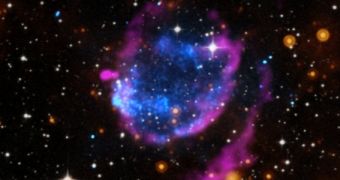Astronomers using a couple of NASA's Great Observatories were recently able to capture a new, highly-detailed image of a supernova remnant called G352.7-01 (G352), which exhibits a series of unusual characteristics. Chief among them is the fact that the blast that produced the remnant was so intense that it swept up no less than 45 solar masses worth of material from around the dying star.
Another interesting aspect of this particular structure is the fact that it seems to produce radio emissions shaped like an ellipse. Filling the radio ellipse is another, large ellipse, this time produced by X-ray radiations. This unusual setup was observed during the recent study, which included the NASA Chandra X-ray Observatory and Spitzer Space Telescope, as well as observatories on Earth.
The image above displays data from Chandra in shades of blue and from Spitzer in orange. Additional information was provided by the US National Science Foundation's (NSF) Karl G. Jansky Very Large Array (VLA) in radio wavelengths (pink) and the Digitized Sky Survey in visible light (white). This unique collaboration enabled the creation of this multi-wavelength, high-detail photo of G352.
According to astronomers, it is very unusual for a supernova remnant to exhibit different shapes in emissions clouds produced at different wavelengths – in this case, between radio and X-ray radiations. At the same time, G352 is one of the few known SNRs to be dominated by hotter debris from the stellar explosion that caused it, rather than by emissions produced by the swept-up material all around.
When a supernova event occurs, vast amounts of material such as cosmic gas and dust from around the exploding star are pushed outwards after being accelerated to great speeds. This, and associated shock waves, heats up the material to millions of degrees, which causes it to release vast amounts of radiations.
In the case of SNR G352, experts noticed that debris left behind by the exploding stars – heated up to around 30 million degrees – produce more radiations than the material that was swept up following the blast. At its age, roughly 2,200 years old, this remnant should have long since been dominated by radiations released from the swept-up material.
It is worth mentioning here that supernova blasts are some of the most energetic phenomena in the entire Universe. When massive stars blow up, they can briefly outshine entire galaxies, and the light they release can take centuries to millennia to subside. An unbelievably-high amount of energy is produced during these explosions, which then goes on to heat the material around the former star.
“Although it does not produce a lot of X-ray emission, the amount of material […] swept up by G352 is remarkably high for a supernova remnant located in our Galaxy. This may indicate that a special type of evolution has occurred, in which the massive star that exploded to create G352 interacted with an extraordinary amount of dense surrounding material,” NASA astronomers say in a press release.
The final weird aspect of G352 is that the SNR has thus far revealed no traces of a neutron star, a special type of star that is produced from the collapsed cores of massive stars. Astronomers are still looking for signs of such an object, but thus far their investigation has revealed nothing of the sort.

 14 DAY TRIAL //
14 DAY TRIAL //